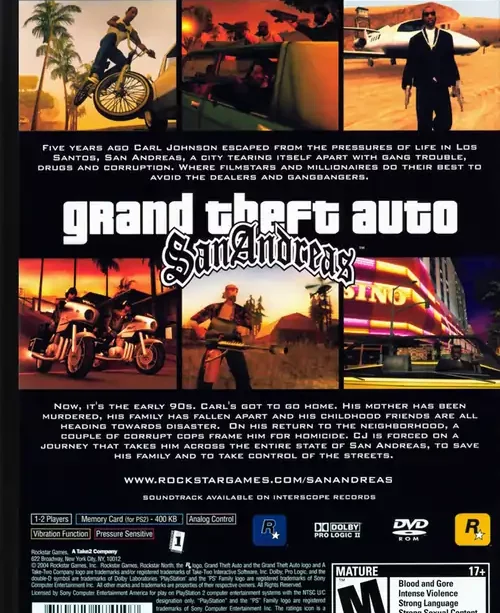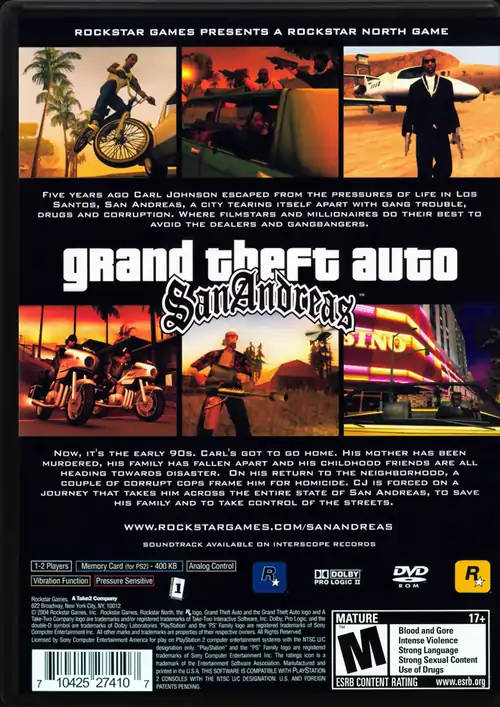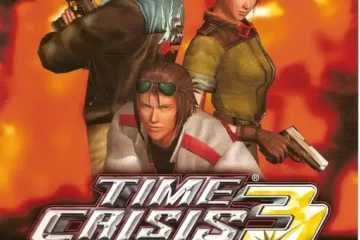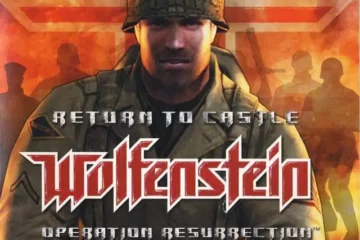
Grand Theft Auto: San Andreas

Console: PS2
Publisher: Rockstar Games
Genre: Action, Adventure
Region: WW
Released: 26 October 2004
File size: 2.9 GB
Step into the streets of San Andreas and take control of CJ’s story of crime, loyalty, and survival.
Released October 26, 2004, Grand Theft Auto: San Andreas didn’t just set a new standard for open-world action-adventure on PlayStation 2 – it completely rewrote the playbook. This wasn’t just another crime sandbox; it was Rockstar North’s ambitious love letter to 1990s California, wrapped up in an epic story that blended family drama, gang warfare, and government conspiracy into something truly extraordinary.
The Landmark Release That Changed Everything
When San Andreas hit PlayStation 2, it represented something unprecedented in gaming. Sure, we’d seen open-world games before, but nothing came close to the sheer scope and ambition of what Rockstar North had created. This was the fifth entry in the Grand Theft Auto series and what would become the final mainline title on PlayStation 2 – and boy, did they go out with a bang.
The fictional state of San Andreas wasn’t just big; it was absolutely massive by 2004 standards. We’re talking about three complete cities – Los Santos (clearly inspired by Los Angeles), San Fierro (a dead ringer for San Francisco), and Las Venturas (Las Vegas with the serial numbers filed off) – plus vast rural areas that felt like actual countryside rather than empty space between mission points.
At the center of it all was Carl “CJ” Johnson, a character who felt more real and relatable than any previous GTA protagonist. He wasn’t just a criminal for the sake of being criminal; he was a guy coming home to deal with family tragedy, neighborhood politics, and the kind of personal demons that made you actually care about what happened to him.
Sales Success That Broke Records
The numbers tell the story of San Andreas’ incredible impact. With over 17.33 million copies sold on PlayStation 2 alone, it became the best-selling game in the console’s entire library. That’s not just impressive – that’s absolutely mind-blowing when you consider the competition it faced from franchises like Final Fantasy, Metal Gear, and Gran Turismo.
Record-Breaking Achievement:
- 17.33 million copies sold on PS2 (best-selling PS2 game ever)
- 95/100 Metacritic score (universal critical acclaim)
- Game of the Year awards from BAFTA and Spike TV
- Over 70 hours of gameplay content
Innovative Gameplay Features That Defined a Generation
What made San Andreas special wasn’t just its size – it was how alive and interactive the world felt. Every system in the game seemed designed to make you feel like you were actually living in this criminal underworld rather than just visiting it for missions.
Revolutionary RPG Mechanics
Here’s where San Andreas really blew minds in 2004: they took the GTA formula and added RPG-style character progression that actually mattered. CJ wasn’t just a static character who could magically drive any vehicle or shoot any weapon perfectly from day one. Instead, his skills developed based on what you actually did.
Spend time running around the neighborhoods? Your stamina improved. Hit the gym regularly? CJ got visibly buffer and could throw harder punches. Drive motorcycles constantly? Your bike handling became smooth as silk. This wasn’t just cosmetic – these changes affected gameplay in meaningful ways that made you feel invested in CJ’s personal growth.
Character Development Systems:
- Stamina – Improved through running and swimming activities
- Strength – Built up through gym workouts and melee combat
- Driving Skills – Enhanced by actually driving different vehicle types
- Weapon Proficiency – Increased accuracy and reload speed through practice
- Respect Levels – Affected by clothing choices, territory control, and mission success
Character Customization Like Never Before
The customization system in San Andreas was revolutionary for its time. This wasn’t just about picking different colored shirts – your clothing choices, hairstyles, and tattoos actually affected how NPCs reacted to you and how much respect you commanded in different neighborhoods.
Roll into Ballas territory wearing the wrong colors? You’d better be ready for a fight. Show up to a fancy casino looking like you just crawled out of the gym? Don’t expect the VIP treatment. The game actually paid attention to how you presented yourself, which added layers of strategy to something as simple as getting dressed.
And let’s talk about the eating and exercise system – another feature that was way ahead of its time. Eat too much fast food, and CJ would gain weight, affecting his stamina and how clothes fit. Hit the gym regularly, and he’d bulk up, becoming stronger in combat. It was the kind of attention to detail that made the world feel genuinely reactive to your choices.
Vehicle Variety That Boggled the Mind
San Andreas featured hundreds of drivable vehicles, and I mean hundreds. We’re talking lowriders with hydraulics, sports cars, motorcycles, bicycles, boats, planes, helicopters, tanks, and even a jetpack. Each category had its own handling characteristics and learning curve, making vehicle mastery part of the overall progression system.
The fact that you could take a bicycle from the streets of Los Santos, pedal out to the countryside, then steal a plane and fly to Las Venturas was nothing short of magical in 2004. This level of transportation freedom was unprecedented and set expectations for open-world games that developers are still trying to meet today.
Interactive World Systems That Felt Alive
What separated San Andreas from its predecessors wasn’t just the size of the world – it was how that world reacted to your presence. Every system felt interconnected, creating emergent gameplay moments that nobody could have scripted.
Gang Territory Warfare
The gang territory system was pure genius. Los Santos was divided into different colored zones on the map, each controlled by various gangs. As CJ, you could actively participate in turf wars, taking territory for the Grove Street Families and watching the map literally change colors as your influence expanded.
These weren’t just cosmetic changes – controlling territory meant safer passage through certain areas, backup from friendly gang members, and a real sense of progression that extended beyond the main story missions. You could spend dozens of hours just focused on territorial conquest, turning Los Santos into your own personal empire.
Dynamic Wanted System
The wanted level system in San Andreas was more sophisticated than anything we’d seen before. Commit crimes in rural areas, and you’d face different law enforcement responses than causing chaos in downtown Los Santos. The police, FBI, and military all had distinct behaviors and escalation patterns that made every chase feel unique.
What made it special was how the system remembered your actions. Certain areas would have heightened security if you’d caused trouble there recently, and law enforcement would adapt their tactics based on your preferred methods of mayhem.
The Soundtrack That Defined an Era
Let’s be real – San Andreas had one of the greatest video game soundtracks ever assembled. Over 150 licensed tracks across ten radio stations, each perfectly curated to represent different aspects of early 1990s California culture. This wasn’t just background music; it was cultural education wrapped in entertainment.
Iconic Radio Stations:
- Radio Los Santos – Hip-hop and rap defining West Coast culture
- K-Rose – Country music for those long desert drives
- Radio X – Alternative rock that captured the ’90s perfectly
- Bounce FM – Classic funk and soul for cruising the city
- WCTR – Talk radio with satirical commentary on American society
The radio stations weren’t just music players – they were character development tools. The songs you heard while driving through different neighborhoods helped establish the mood and atmosphere of each area. Cruising through the hood with NWA pumping through the speakers felt completely different from flying a plane over the desert listening to classic rock.
Technical and Artistic Achievements on PlayStation 2
What Rockstar North accomplished with San Andreas on PlayStation 2 hardware still impresses me today. This was a console from 2000 running a game that felt like it belonged on more powerful hardware. The technical wizardry required to make this world function smoothly was nothing short of remarkable.
Seamless Loading Technology
One of San Andreas’ most impressive technical achievements was its streaming technology. You could drive from one end of the state to the other without hitting a single loading screen. The game quietly loaded and unloaded sections of the world as you moved through it, creating the illusion of one massive, continuous environment.
This wasn’t just about technical showboating – it was about preserving immersion. Breaking the flow with loading screens would have shattered the illusion of living in this world. Instead, you could seamlessly transition from urban street racing to rural airplane stunts without missing a beat.
Dynamic Weather and Day-Night Systems
The dynamic weather system wasn’t just eye candy – it affected gameplay in meaningful ways. Rain made driving more dangerous, fog reduced visibility for both you and law enforcement, and time of day affected which missions were available and how NPCs behaved.
Certain illegal activities were easier to pull off under cover of darkness, while some missions required specific weather conditions or times of day. This added another layer of strategic thinking to how you approached different challenges.
Voice Acting Excellence
The voice acting in San Andreas was absolutely top-tier. Young Maylay’s performance as CJ felt authentic and emotionally grounded, while celebrity appearances from Samuel L. Jackson, James Woods, and others never felt like stunt casting. Every character had personality and depth that made the world feel populated by real people rather than video game NPCs.
The dialogue writing tackled serious themes – family loyalty, systemic corruption, the drug epidemic, racial tensions – with a maturity that elevated the entire experience. This wasn’t just crime fantasy; it was social commentary wrapped in interactive entertainment.
Mission Variety That Kept You Guessing
San Andreas featured some of the most diverse and creative mission design in gaming history. One minute you’re participating in a high-stakes casino heist, the next you’re piloting a remote-controlled airplane through an obstacle course. The variety was absolutely staggering and helped prevent the repetitive mission structure that plagued many open-world games.
Story Missions With Hollywood Production Values
The main story missions felt like interactive Hollywood blockbusters. The “Black Project” mission, where you infiltrate Area 69 to steal a jetpack, was pure science fiction adventure. “End of the Line,” the climactic final mission, delivered the kind of explosive action sequence that would make Michael Bay jealous.
What made these missions special wasn’t just their spectacle – it was how they served the narrative. Each major set piece revealed something new about CJ’s character or advanced the overarching conspiracy plot in meaningful ways.
Side Missions With Real Purpose
The side missions in San Andreas weren’t just time-wasters – they were legitimate gameplay experiences with their own progression systems and rewards. Taxi driving missions improved your knowledge of the city layout. Vigilante missions enhanced your combat skills. Trucking missions familiarized you with the rural highway system.
Even the dating system served multiple purposes. Maintaining relationships with different girlfriends unlocked various perks and customization options, while also adding emotional depth to CJ’s character development.
Critical and Commercial Success That Defied Expectations
San Andreas didn’t just succeed – it dominated. The critical reception was universally positive, with reviewers praising everything from its technical achievements to its narrative ambition. But more importantly, it resonated with players in a way that few games manage to achieve.
Critical Acclaim:
- Metacritic Score: 95/100 on PlayStation 2
- Frequently cited among the greatest video games ever made
- Game of the Year awards from multiple prestigious outlets
- Influenced countless open-world titles that followed
The commercial success was equally impressive. Those 17.33 million copies sold on PlayStation 2 represent just a fraction of the game’s total sales across all platforms. When you include PC, Xbox, mobile, and remastered editions, San Andreas has sold well over 30 million copies worldwide.
Enduring Legacy and Cultural Impact
Twenty years later, San Andreas continues to cast a long shadow over the gaming industry. Its influence can be seen in virtually every open-world game that followed, from the RPG progression systems in modern action games to the seamless world design that players now take for granted.
The Modding Community That Kept It Alive
One of San Andreas’ most remarkable achievements is its thriving modding community. Enthusiastic players on PC have created thousands of modifications that restore original graphics, add new missions, introduce multiplayer functionality, and even recreate entire other games within the San Andreas engine.
Projects like Multi Theft Auto and SA-MP (San Andreas Multiplayer) transformed the single-player experience into massive online worlds where hundreds of players could interact simultaneously. These weren’t just technical achievements – they were cultural phenomena that kept San Andreas relevant long after newer games had claimed the spotlight.
Remastered Editions for New Generations
The inclusion of San Andreas in GTA: The Trilogy – Definitive Edition introduced the game to new audiences while providing quality-of-life improvements that modernized the experience. Updated graphics, improved controls, and enhanced performance made this PlayStation 2 classic accessible to players who might have found the original too dated.
Memes and Cultural References
San Andreas spawned countless internet memes that remain popular today. “All we had to do was follow the damn train, CJ!” became one of gaming’s most recognizable quotes. “Ah shit, here we go again” transcended gaming to become a general cultural reference. Big Smoke’s elaborate fast food order became legendary among fans.
These moments of cultural penetration demonstrate how deeply San Andreas embedded itself in popular consciousness. It wasn’t just a game people played – it was an experience they shared and remembered.
Influence on Future Open-World Games
The fingerprints of San Andreas can be found on virtually every major open-world game released since 2004. The RPG progression systems that seemed revolutionary at the time are now standard features in games like Red Dead Redemption, Watch Dogs, and even action RPGs like The Witcher 3.
The seamless world design, dynamic weather systems, character customization depth, and narrative integration of open-world activities all became industry standards partly due to San Andreas proving their effectiveness. Modern games like Cyberpunk 2077 and Spider-Man still struggle to achieve the level of world interactivity that San Andreas delivered on 2000 hardware.
The Blueprint for Ambitious Game Design
Perhaps San Andreas’ greatest legacy is how it demonstrated that ambitious game design could succeed commercially. Before San Andreas, conventional wisdom suggested that players would be overwhelmed by too much content or too many systems. The game proved that players were hungry for deeper, more complex experiences that treated them as intelligent adults.
This lesson influenced not just Rockstar’s future projects but the entire industry’s approach to open-world design. Games like Grand Theft Auto V, Red Dead Redemption 2, and countless others owe their existence to San Andreas proving that bigger, more complex games could find mainstream success.
The game also demonstrated how to handle mature themes in interactive entertainment. Its exploration of gang culture, police corruption, and socioeconomic inequality was handled with nuance and respect, paving the way for games to tackle serious social issues without sacrificing entertainment value.
San Andreas stands as both the pinnacle of PlayStation 2’s capabilities and a blueprint for ambitious open-world design. Its influence continues to be felt in today’s most expansive games, from the character progression systems in modern RPGs to the seamless world design that players now consider standard. More than just a technical achievement, it proved that video games could be vehicles for meaningful storytelling and social commentary while delivering the kind of freedom and agency that makes interactive entertainment unique.
Whether you experienced San Andreas during its original PlayStation 2 run or discovered it through one of its many re-releases and remasters, the game remains essential gaming. It’s a masterpiece that defined a generation of players and established design principles that continue to influence game development two decades later. In the pantheon of gaming’s greatest achievements, Grand Theft Auto: San Andreas stands as a towering monument to what’s possible when technical innovation meets creative ambition.
Related PlayStation 2 Games:
Tom Clancy’s Splinter Cell – Chaos Theory
October 24, 2025Time Crisis 3
October 24, 2025Return to Castle Wolfenstein: Operation Resurrection
October 24, 2025



